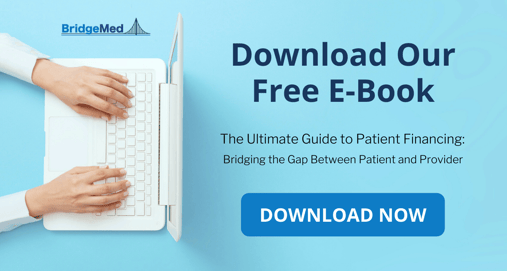The Power of Personalized Payment Plans
-1.png)
Over the last several years, the financial component of healthcare has become just as important, if not more so, as the physical component. Due to the rise of high deductible healthcare plans, the growing number of uninsured Americans, and increasing out-of-pocket costs, patients all across the country are struggling to afford care. 54% of Americans reported having delayed or avoided care due to cost, some for as long as a year. Even those with health coverage struggle with surprise bills not covered by their insurance.
In order for healthcare providers to collect on receivables, they must offer their patients better options to pay for care. Personalized payment plans close the gap between what patients can afford and what they owe, while also opening the doors to people that typically defer care due to cost.
Empowering Patients to Pay
The number one reason for non-payment is due to a lack of payment options, not an unwillingness to pay. With 74% of patients confused by Explanation of Benefits (EOBs) and medical bills, providers must prioritize cost transparency and affordable payment options as a way to empower patients to pay. By offering personalized payment plans, healthcare organizations are able to include patients that would otherwise struggle to meet the non-negotiable terms or requirements of more rigid plans. Elements such as predetermined payment amounts and credit score minimums often leave patients with bills they cannot pay, ultimately resulting in unpaid bills and dissatisfied patients.
Additionally, personalized financing plans acknowledge that patients have a wide variety of circumstances and give Americans from all backgrounds access to affordable healthcare options. Implementing a customizable financing program with flexible payment timelines, affordable monthly amounts, and a variety of payment methods paves a pathway that customers are able to follow based on their needs. Giving patients more control over their healthcare finances improves the likelihood they will pay, and improve their overall experience.
Simple, Easy, Accessible
As healthcare becomes more like retail, consumers expect a seamless payment cycle with a streamlined financial experience. Like retail, patients are accustomed to digitized billing processes that are accessible from their smartphone or tablet. Patients are less willing to call the hospital billing department to ask questions about a statement or get clarification, they want answers at the click of a button.
80% of patients say they would prefer to pay for their care online, meaning that hospitals and healthcare systems need to provide user-friendly patient portals that allow customers to easily manage their healthcare finances. Fortunately, this can be rolled out with personalized patient financing programs. Patients are able to digitally and conveniently enroll in a payment plan, manage their finances, and make payments all in one place–without the involvement of the provider's RCM staff.
Improved Patient Experience
At the forefront of improving a patient's healthcare journey is improving the patient's financial experience. 65% of patients reported they would consider switching providers for a better financial experience, indicating that a positive payment experience boosts patient satisfaction and loyalty.
Personalized payment plans improve the patient experience by giving customers more options to conquer their financial challenges. Patients can get treatment without fear of not being able to pay, allowing them to prioritize their health without compromising their budget. Furthermore, the more customization and flexibility available within a financing program, the more likely the patient is to have a positive financial experience.
Where Patients Benefit, Providers Benefit
With health systems growing more dependent on patient responsibility payments, they can no longer afford not to offer solutions to help patients cover their out-of-pocket medical expenses. By implementing personalizable financing program, providers can expect the following benefits:
Increased speed to cash
Slow payment on patient receivables can lead to significant financial strain on a healthcare system. Giving patients the opportunity to finance their medical expenses increases the likelihood that patients will make payments, and make payments on time. Non-recourse programs pay the provider upfront on receivables, which further improves cash flow. Payments are received within days, not months, providing a steady stream of revenue into the practice.
Improved collections
Personalized payment plans provide a pre-bad debt solution by allowing patients to pay their bills in small amounts over time. By setting up a plan tailored to each patient's needs, providers avoid having accounts sent to collections. Personalized payment plans have the ability to increase patient collections by up to 200% and can be implemented at any point in the revenue cycle.
Increase patient volume
Utilizing a tailored solution that puts patients' needs first attracts a larger, more diverse pool of patients to your healthcare organizations. 49% of patients said having clear information on expected out-of-pocket costs before receiving treatment impacts their decision to use a healthcare provider. Providers that offer personalized payment plans not only draw new patients into their practice, but also increase the likelihood those patients return for future visits and refer others.
As healthcare continues to evolve into a consumer-driven marketplace, healthcare organizations must adopt innovative solutions to keep patients engaged in both their care and financial responsibilities. Affordability remains a significant challenge for many Americans seeking care, necessitating adjustments in the billing process to accommodate those who struggle to pay. By offering digital, personalized financing options, healthcare organizations can bridge the gap between what patients owe and what they can afford, thereby reducing stress and making expense management more convenient. Assisting patients in navigating their financial journey also benefits providers by preventing revenue loss from deferred care and unpaid accounts sent to collections.
Discover how BridgeMed can benefit both your patients and your healthcare organization with non-recourse flexible payment programs at www.mybridgemed.com.
